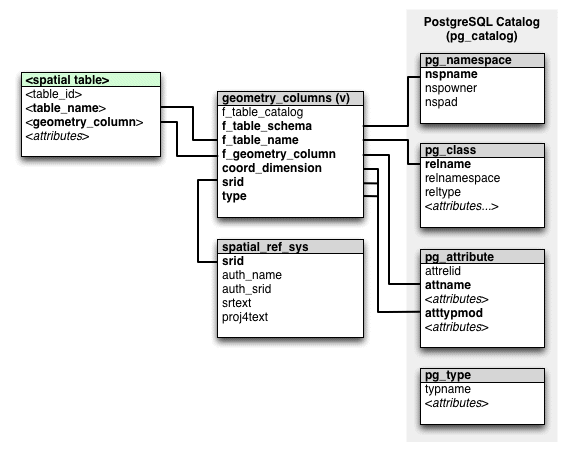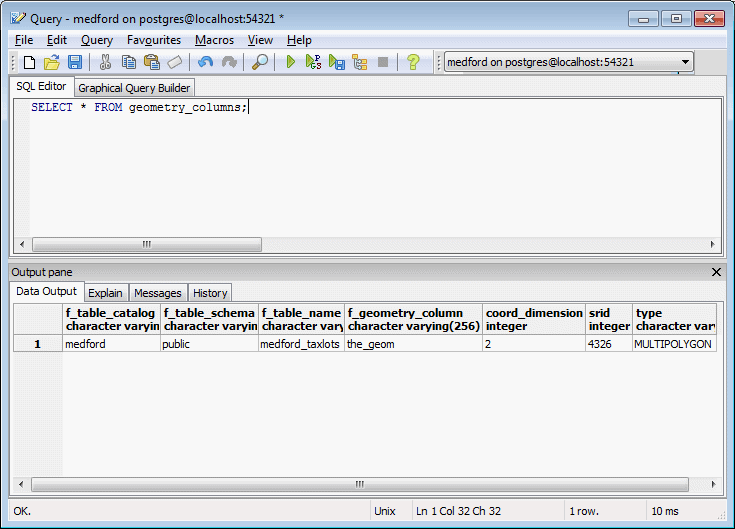OpenGIS metadata¶
In compliance with the OpenGIS Simple Features for SQL (SFSQL) specification, PostGIS stores and manages metadata for all geometry columns present in a database. As a result, client applications are not required to inspect individual spatial tables and their geometries to perform display, projection, or analytical queries.
The metadata is managed by the postgres user account and stored in the following PostgreSQL schema objects:
spatial_ref_sys—Table recording spatial reference systemsgeometry_columns—Read-only view listing spatial (or feature) tables, geometry columns and geometry types present in the databasegeography_columns—Read-only view listing spatial (or feature) tables, geography columns and geography types present in the database

Spatial metadata schema relationships
As PostGIS 2.0+ (OpenGeo Suite 3.0+) uses a view based on the system catalogs rather than a table to record geometry column metadata, the view is always current, updated automatically when a new spatial table is created.
Note
PostGIS 1.X managed metadata in tables, not views, and used a number of the system utility functions, such as populate_geometry_columns(). In PostGIS 2.X running these utility functions is no longer required.
To query the geometry_columns view, execute the following SQL command:
SELECT * FROM geometry_columns;

geometry_columns view
The attributes of the geometry_columns view are:
f_table_catalog,f_table_schema,f_table_name—Fully qualified name of the spatial tablef_geometry_column—Name of the geometry column (for spatial tables with multiple geometry columns, there will be one record for each column)coord_dimension—Dimension of the geometry (2-, 3- or 4-dimensions)srid—Spatial reference identifier in thespatial_ref_systabletype—Type of geometry (such aspointorlinestring)
Typmods¶
PostGIS 2.0+ also adds support for type modifiers, or typmods, on geometry objects. Typmods provide a method of specifying additional information for a column definition. For example:
CREATE TABLE test (
description VARCHAR(255)
)
The typmod in this case is the number 255, indicating the maximum length of values in the description field. By applying a typmod to a geometry column, you can specify the geometry type, dimensionality and spatial reference identifier. To create a new spatial table geotbl with a geometry column of type point, dimensionality Z, and a spatial reference identifier of 4326, the following typmod definition is required:
CREATE TABLE geotbl (
geom GEOMETRY(PointZ, 4326)
)
Updating spatial tables¶
Updating spatial tables in previous versions of PostGIS, such as changing the spatial reference or geometry type, was a multi-step process—dropping constraints, updating the table, updating the geometry_columns table and re-applying the constraints. With version 2.0+, this can be accomplished with a single ALTER TABLE command. The following example will simultaneously alter the dimensionality and projection of the data as well as the associated table constraints:
ALTER TABLE geotabl
ALTER COLUMN geom
SET DATA TYPE geometry(Point,26910)
USING ST_Transform(ST_Force_2D(geom, 26910))
The geometry_columns view is updated automatically to reflect the changes.
Manually registering geometry columns¶
There may still be occasions when you are required to manually register a geometry column, such as when working with SQL views or bulk data inserts. With PostGIS 2.0+ if the definition of a geometry column is typmod-based, the view or table creation process will automatically register the column correctly, so no further action is required. However, if a geometry column in an existing view is constraint-based, it will not be registered correctly.
For example, if a view is defined as follows:
CREATE VIEW public.vw_mytable AS
SELECT gid, ST_Transform(geom, 3395) AS geom, f_name
FROM public.mytable;
Querying the geometry_columns view will confirm the incorrect registration of the geometry column:
SELECT f_table_name, f_geometry_column, srid, type
FROM geometry_columns
WHERE f_table_name = 'public.vw_mytable';
f_table_name | f_geometry_column | srid | type
-------------+-------------------+------+----------
vw_mytable | geom | 0 | GEOMETRY
-------------+-------------------+------+----------
To register the geometry column with PostGIS 2.0+, you must convert, or cast, the geometry to be typmod-based:
DROP VIEW public.vw_mytable;
CREATE VIEW public.vw_mytable AS
SELECT gid, ST_Transform(geom,3395)::geometry(Geometry, 3395) AS geom, f_name
FROM public.mytable;
If the geometry type is known to be a 2D polygon, the view could be redefined as:
DROP VIEW public.vw_mytable;
CREATE VIEW public.vw_mytable AS
SELECT gid, ST_Transform(geom,3395)::geometry(Polygon, 3395) AS geom, f_name
FROM public.mytable;
Querying the geometry_columns view again will report the update.
SELECT f_table_name, f_geometry_column, srid, type
FROM geometry_columns
WHERE f_table_name = 'public.vw_mytable';
f_table_name | f_geometry_column | srid | type
-------------+-------------------+-------+----------
vw_mytable | geom | 3395 | GEOMETRY
-------------+-------------------+-------+----------
The geometry column is now correctly registered.
If you wish to add a geometry column to an existing table, the function AddGeometryColumn() now uses a typmod by default to define the column, rather than constraints.
AddGeometryColumn() accepts the following parameters:
AddGeometryColumn(varchar table_name, varchar column_name, integer srid, varchar type, integer dimension, boolean use_typmod=true);
SELECT AddGeometryColumn('my_table', 'geom', 4326, 'POINT', 2);
To add a point using constraint-based behavior, set the use_typemod value to be false.
SELECT AddGeometryColumn('my_table', 'geom', 4326, 'POINT', 2, false);
Note
AddGeometryColumn() no longer updates the geometry_columns view as the view reads directly from the system catalogs.